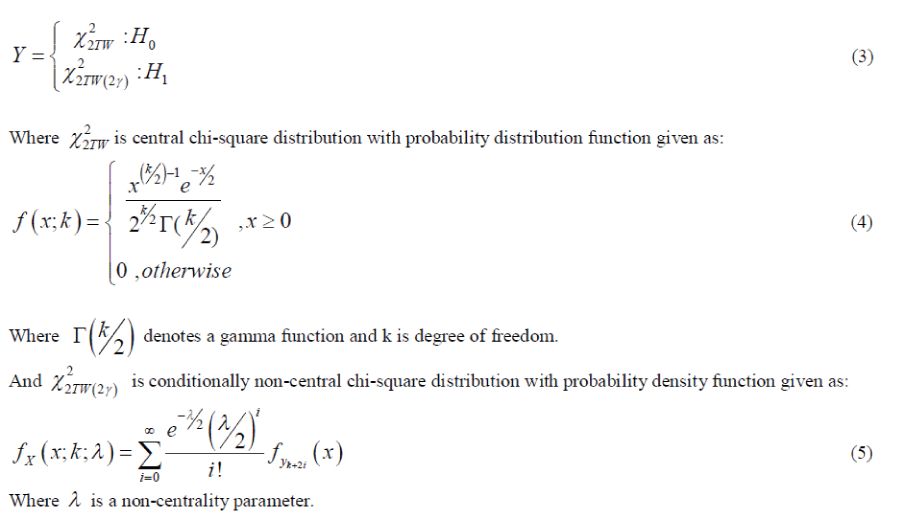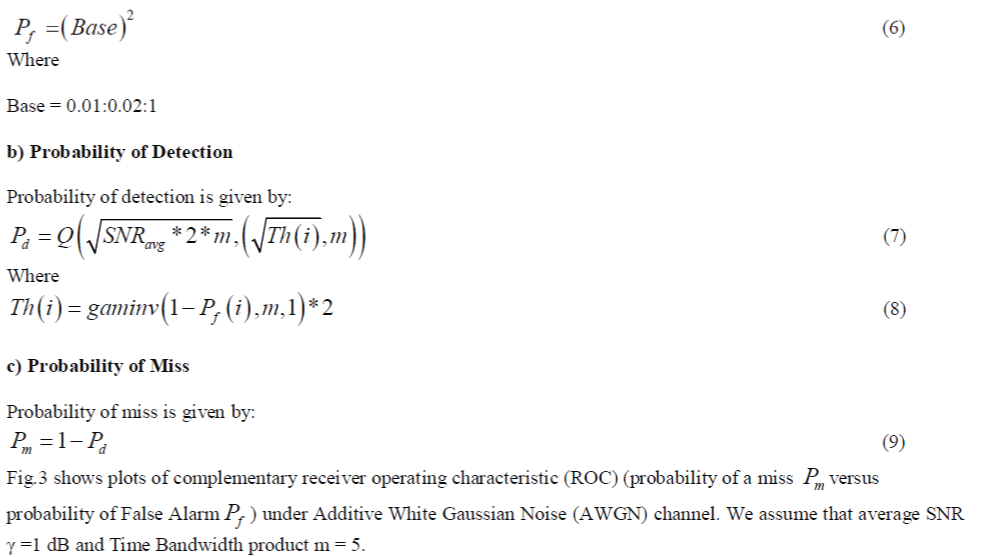ISSN ONLINE(2278-8875) PRINT (2320-3765)
ISSN ONLINE(2278-8875) PRINT (2320-3765)
R.Gill1, A.Kansal2
|
| Related article at Pubmed, Scholar Google |
Visit for more related articles at International Journal of Advanced Research in Electrical, Electronics and Instrumentation Engineering
cognitive radio is the solution for effectively utilizing the underutilized radio spectrum. There are many techniques to sense spectrum using cognitive radios like matched filter detection, energy detection, waveform based detection, cyclostationary feature detection and so on. In this paper comparative analysis of two popular techniques i.e. energy detection (ED) and cyclostationary feature detection (CFD) is discussed. Analysis is carried out by discussing the theoretical aspect of both the techniques supported by simulation graphs and plots. This analysis shows that among the two techniques discussed CFD shows better results
Keywords |
||||||||||||
| Cognitive Radio, Energy Detection, Cyclostationary Feature Detection. | ||||||||||||
INTRODUCTION |
||||||||||||
| These days due to advancement in wireless communication [1], the demand for various types of mobile services have increased and higher data-rates are required. In order to increase data rates more spectrum is required .most of the spectrum is allocated to television and radio broadcasts known as primary users (PU) but it has been observed that 70% of the spectrum is underutilized because the spectrum allocated to PU remains unutilized for certain time in a day. This spectrum can be allocated to unlicensed users called as secondary users (SU).This can be done with the help of cognitive radios. Cognitive radios [2] perform four main operations: spectrum identification, spectrum detection, spectrum tracking and spectrum exploitation. Spectrum identification means determining whether the spectrum hole is wide enough in frequency to accommodate bandwidth of SU. Once a spectrum opportunity has been identified by a secondary user, the SU must detect when such opportunities exist and when they do not. Spectrum tracking is keeping track of the variations in the spectrum availability. Once the SU has gained knowledge about the spectrum it can access spectrum opportunities with a lower probability of interference. There are many techniques for sensing spectrum. In this paper, comparative analysis of two techniques namely energy detection and cyclostationary feature detection is discussed below. | ||||||||||||
LITERATURE SURVEY |
||||||||||||
| In this section work that has been done over the past years in the field of cognitive radios for spectrum sensing has been discussed: | ||||||||||||
| 1. W.Y Lee et al. (in 2005) introduced an optimal sensing framework with three different functionalities. Firstly, sensing parameter optimization is proposed to maximize the sensing efficiency. Secondly, a spectrum selection and scheduling algorithm based on opportunistic capacity concept is introduced to extend multi-spectrum environment and lastly cooperation sensing is used. | ||||||||||||
| 2. T. Yucek et al. (in 2009) re-examined various aspects and methodologies of spectrum sensing. Various challenges related to spectrum sensing are discussed along with their possible solutions like cooperative sensing, external sensing algorithm and other alternatives. Furthermore, in order to predict PU behaviour a statistical modelling of network traffic is studied and utilization of these models is discussed. | ||||||||||||
| 3. K.J.R. Liu et al. (in 2011) studied the effect of errors in the spectrum sensing process on the performance of the multiple access layers of both primary and secondary networks and concluded that using different designs for spectrum sensing and the channel access mechanisms can Detroit the performance of both primary and secondary networks. So in this paper a joint design of spectrum sensing and channel access mechanisms is proposed which uses binary hypothesis testing to check the reliability of outcome. Proposed technique achieves significant improvement in throughput of both PU and SU networks. | ||||||||||||
| 4. S. Maleki et al. (in 2013) designed a censored truncated sequential technique for spectrum sensing as an energy-saving approach. To design this technique, average energy consumption of each sensor is minimized to a lower bound of probability of detection and an upper bound of false alarm rate to control the interference to the PU due to miss detection and the network throughput as a result of a low false alarm rate. Lastly, the performance of the proposed scheme is compared with a fixed sample size censoring scheme under different cases and it is shown that that for low-power cognitive radios, proposed technique outperforms existing technique. | ||||||||||||
ENERGY DETECTION |
||||||||||||
| Energy detection (ED) [3] is the most optimal choice for the spectrum sensing where it is difficult for the Cognitive Radio (CR) to get the adequate information about the licensed user waveform. The ED is the most suitable choice when the CR [4] has information about the power of the random Gaussian noise. The basic approach behind this technique is the power estimation of the licensed user (primary user) signal. In this technique, energy of the desired transmitted signal is detected then this detected energy is compared with a threshold value. The threshold is a pre-defined value. If the detected energy is below than threshold value then it is pretended that the licensed user is not present and the spectrum is free. Oppositely, if the detected energy is above the threshold value then it is assumed that the spectrum is not free as shown in Figure 1. | ||||||||||||
| The block named Energy Detector consist of three main components, these are Band Pass Filter (BPF), squaring device, and integrator. | ||||||||||||
 |
||||||||||||
| Then BPF is followed by a squaring device to measure the received energy and an integrator which determines the energy Y of the received signal r (t) over a period T. output Y is compared with threshold value which is given by two different distributions for both hypothesis as given below: | ||||||||||||
 |
||||||||||||
| In order to measure the performance of the applied technique three main parameters are calculated. These are: | ||||||||||||
a) False Alarm Probability |
||||||||||||
| False alarm probability for energy detection is calculated as: | ||||||||||||
 |
||||||||||||
| For given 10 % probability of false alarm, the probability of detection is 89 % under AWGN channels that means probability of miss is 21% as shown in Fig.3: | ||||||||||||
LIMITATIONS OF ENERGY DETECTOR |
||||||||||||
| 1. It doesn’t perform well under the condition of low SNR. | ||||||||||||
| 2. It requires long time to collect data in order to detect the primary user reliably. | ||||||||||||
| 3. Energy Detection measures only the signal power so it is prone to false detection. | ||||||||||||
| 4. It is impossible to distinguish between different primary users because energy Detector is not able to differentiate between the sources of the received energy. | ||||||||||||
CYCLOSTATIONARY FEATURE DETECTION |
||||||||||||
| Most of the signal processing techniques used currently uses probabilistic methods to intercept signal i.e. they describe the signal on average as discussed in energy detection above, which reduces the amount of data required for featuring a signal and deriving information from it. But most of the signals used in communication system vary with time like Amplitude Modulation, Phase Modulation, Frequency Modulation, and Amplitude Shift Keying, Frequency Shift Keying etc. this requires that the random signal be modelled as cyclotationary [6], in which the statistical parameters vary in time with single or multiple periodicities. | ||||||||||||
CYCLOSTATIONARITY |
||||||||||||
| Consider a signal | ||||||||||||
| If Fourier coefficient of the above signal given by equation below calculated is non zero then the signal is said to exhibit first order periodicity. | ||||||||||||
| Fourier coefficient of above signal is: | ||||||||||||
 |
||||||||||||
| In above equation operation is the time averaging operation given by: | ||||||||||||
 |
||||||||||||
| This shows that Power Spectral Density (PSD) of x(t) includes two spectral lines at f and f . So a signal is said to be cyclostaionary signal if its Fourier coefficient is non zero and its non linear transformation produces spectral lines. | ||||||||||||
| Block diagram of CFD is shown above. Input signal is passed through a window to limit the length of the signal. It is then multiplied with complex exponentials say A1 and A2. Then N-point Fast Fourier Transform (FFT) of both A1 and A2 is calculated and conjugate of A2 is carried out. In next step these two signals are again multiplied and finally correlation and averaging is done to get cyclic spectrum [7] as output. | ||||||||||||
| Fig.5 shows a 3D plot plotted for three parameters namely Cyclic Spectrum, Frequency and Cyclic Frequency. The plot shows the presence of primary user at alpha=0, for a small range of frequency with Cyclic spectrum value= 0.5 (approx). | ||||||||||||
| In order to plot complementary ROC curve for CFD [8] probability of false alarm and probability of detection are given as: | ||||||||||||
 |
||||||||||||
| Probability of Detection: | ||||||||||||
 |
||||||||||||
LIMITATIONS OF THE CYCLOSTATIONARY DETECTION |
||||||||||||
| The CFD is more robust to uncertain levels of noise and gives much better performance in low SNR regions. However, this technique has its own limitations: | ||||||||||||
| 1. High computational complexity. | ||||||||||||
| 2. Long sensing time | ||||||||||||
RESULT |
||||||||||||
|
|
||||||||||||
| In this section, Comparative results of Energy detection and Cyclostationary Feature Detection are shown with complementary ROC curve between probability of miss and probability of false alarm for different values of SNR. | ||||||||||||
| In above plot, black dotted line represents ED and blue dotted line represents CFD for SNR=1. It can be clearly observed that for same low value of SNR=1, 10 2 f P , m P for CFD is reduced by 88.57% as compared to ED. Moreover CFD plots are also obtained for higher values of SNR=1, 3, 5 and it is observed that CFD gives better results as we increase SNR | ||||||||||||
CONCLUSION |
||||||||||||
| To effectively utilize the wireless spectrum cognitive radios were introduced which utilizes the holes present in the spectrum. The most essential aspect of a cognitive radio system is spectrum sensing and various sensing techniques which it uses to sense the spectrum. In this paper comparative analysis of Energy Detection and Cyclosationary Feature Detection is discussed with advantages and disadvantages. Advantage of Energy Detection is that it does not require prior knowledge about the signal but its disadvantage is that it cannot be used at low SNR. Cyclostaionary Feature Detection can be used for low SNR but it is very complex to implement. In this paper Energy Detection method is implemented for AWGN channel and its performance is observed with the help of ROC curve whereas for CFD cyclic spectrum plot is obtained to measure its performance and to compare both methods complementary ROC curve is also shown which shows that CFD is a better technique. In future to improve results techniques like wavelet detection or cooperative sensing can be used for spectrum sensing. | ||||||||||||
Figures at a glance |
||||||||||||
|
||||||||||||
References |
||||||||||||
|